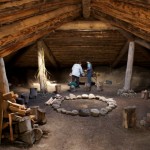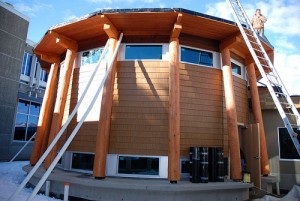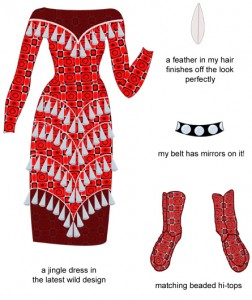Category — Connection to Research Topic
Indigenous Youths, Technology, and Traditional Culture
Indigenous Youths, Technology, and Traditional Culture
This is my first venture in acquiring an in-depth knowledge of indigenous people. I do not have much experience in working with indigenous people; however, as an educator I work with students from different cultural ethnicity. My research therefore will be based on youths and the impact of technology. Given our present globalized world with western ideologies preeminent in our society, I want to know more about indigenous youths, their perspectives on technology, and its impact on their traditional culture; hence my research topic, Indigenous Youths, Technology, and their Traditional Culture.
Technology appears to be very influential in our modern society. This seems to be even more so among our youths, as youths use the internet for games, studying and socialization. Youths also are prone to peer pressure and want to be very much in mode among friends. The emphasis placed on acquiring knowledge on technology is slowly seeping into indigenous communities and the youths are drawn into this ‘new’ development.
While, there can be positivity in using modern technology in maintaining and documenting cultural traditions, the risks of losing the traditional face-to-face communications among indigenous people appears high as indigenous youth are becoming more and more intrigue by technology.
That being said, I would like to explore the impact technology has on indigenous youths and their cultural traditions.
P. Morris
September 29, 2012 No Comments
Teachers’ Views on Western and Aboriginal Science
While researching for my ETEC 521 paper, I came across a tremendously interesting read. And it would so happen, this read fits in beautifully to our current discussion theme. This research paper proposes that teaching is a cultural transmission and learning is a cultural acquisition.
Teachers’ Views on Aboriginal Students Learning Western and Aboriginal Studies
” 1. Teachers generally viewed Western science as course content or as a way of exploring nature, not as a foreign culture as experienced by many of their students.
2. Aboriginal knowledge was respected by science teachers, but only a token amount was added onto, but not integrated with, school science.
3. Teachers thought that the act of learning science was unrelated to their students’ Aboriginal worldviews.
4. Students’ disinterest in pursuing science careers was either unexplainable by the interviewees or was blamed on student deficits. Few teachers blamed their curriculum and teaching. ”
“They need a teacher who is a “culture broker” (Stairs, 1995). A culture-broker science teacher will help students move back and forth between their indigenous culture and the culture of Western science, and will help students deal with cultural conflicts that arise.” (Aikenhead & Huntley)
Although a bit dated, the article had fabulous resources. I do wonder though if this good information was available 15 + years ago -why are we still doing such a dreadful job of enabling our aboriginal students (all of our students) reach their potential?
Aikenhead, G., & Huntley, B. (n.d.). Teachers’ views on aboriginal students learning western and aboriginal studies. Retrieved from http://www.usask.ca/education/people/aikenhead/cjne.pdf
Stairs, A. (1995). Learning processes and teaching roles in Native education: Cultural base and cultural brokerage. In M. Battiste & J. Barman (Eds.), First Nations education in Canada: The circle unfolds. Vancouver, Canada: University of British Columbia Press, pp. 139-153.
November 19, 2011 No Comments
Aboriginal Gathering Places
To support an inquiry project that our district is about to begin, I investigated possible meeting sites for the education stakeholders that will come together in learning and understanding. I was hoping to locate sites other than school district property where all participants could come together.
Three (at least) such sites are within access of our group. To date I have visited two of the sites.
The first is the Mir Centre for Peace. The Doukobors began migrating to the area in 1908. At that time the land was home to First Nations peoples and European settlers. The relationship between the Doukobors and local First Nations were not always peaceful. Land beside Selkirk College was given to the college and late in the 20th Century the idea of the Mir (peace, community, and world) Centre was born. The site was to see the restoration of one of the few remaining Doukobor buildings and space set aside on the land for First Nations Ceremony and Structure.
 The second site that I visited was the Sinixt pit house located in the Slocan valley. Radio carbon dating suggests that the pit house was occupied as early as 3000 years ago and as recently as 200 years ago. In 1987 artifacts, skeletal remains and pit house depressions were discovered when the Ministry of Highways began road construction in the Slocan Valley. Through great restoration efforts the pit house is now an awesome place to visit and in which to learn and reflect. Click on the image of Marylin James to see a short video on the pit house restoration project.
The second site that I visited was the Sinixt pit house located in the Slocan valley. Radio carbon dating suggests that the pit house was occupied as early as 3000 years ago and as recently as 200 years ago. In 1987 artifacts, skeletal remains and pit house depressions were discovered when the Ministry of Highways began road construction in the Slocan Valley. Through great restoration efforts the pit house is now an awesome place to visit and in which to learn and reflect. Click on the image of Marylin James to see a short video on the pit house restoration project.
The third and final site is the Selkirk College Aboriginal Gathering Place. Next on my list for a visit.
Wilkinson, M. (2006, Fall). Mir centre for peace at selkirk college:understanding and building cultures of peace. Retrieved from http://selkirk.ca/media/innovation/mircentreforpeace/history/MIR-History—-Myler’s-09-02-25.pdf
November 19, 2011 No Comments
Who Are We?
Living, learning, and loving on this land claimed by the Ktunaxa, the Sinixt, and the Okanagan, who are we? Of what decent are the families and the students of aboriginal ancestry?
According to Statistics Canada Metis comprise the majority of our FN people. Who are the others? Does the School District have this information?
Statistics Canada provides information for Trail only. The other cities and villages that comprise the school district can not be found. There is no mention of West Kootenay yet East Kootenay and the Boundary Region have statistics. Does this somehow relate to the territorial struggles in this region?
Next step is to see what the school district does or does not know.
Statistics Canada. 2007. Trail, British Columbia (Code5905014) (table). Aboriginal Population Profile. 2006 Census. Statistics Canada Catalogue no. 92-594-XWE. Ottawa. Released January 15, 2008.
http://www12.statcan.ca/census-recensement/2006/dp-pd/prof/92-594/index.cfm?Lang=E
(accessed November 12, 2011).
November 12, 2011 No Comments
Statement Connecting Weblog Posts to Research Interests
Originally, my research interests on the topic of technology and indegeneity centered around language loss and its effect on cultural identity; however, as I compile my resources, my thoughts instinctively lead me to envision how I can incorporate this information into classroom experiences for my students. Moreover, a recurrent theme has emerged in many of the articles that share an indigenous perspective regarding the future prospects of reconciling the relationship between Aboriginal and non-Aboriginal Canadians and it has caught my attention because I believe I am in a privileged position as a teacher to effect change. Misperception radiates from Eurocentric assumptions and has clouded the consciousness of a nation to the point that Canadians are left largely unaware of Aboriginal history and remain indifferent towards indigenous knowledge. The research path that has progressed from this theme leads me towards developing elementary curriculum to illuminate historical and contemporary Aboriginal perspectives that challenge Eurocentric thinking, and the need for a more balanced understanding of the impact colonialism has had on Aboriginal rights and identity as Canada’s indigenous people. I am mindful that my use of technology in this capacity must evoke student’s critical curiosity to build media literacy and initiate a new comprehension of what has been previously determined as fact (Freire, 1997) without unintentionally perpetuating the silent curriculum that our educational system was founded on or encouraging the Eurocentric social and political economy Canada has become accustomed to.
Freire, P. (1997) Pedagogy of the Heart. New York: Continuum.
October 31, 2011 No Comments
Module 3: Media
Excerpt: Storytellers in Motion Episode 12: The Maori Voice Part One: http://youtu.be/sJLRruZNJfU
Excerpt: Storytellers in Motion Episode 13: The Maori Voice Part Two: http://youtu.be/vdfRT3bidvI
The series looks at storytellers in Canada and other countries. These two episodes look at the huge resurgence in Maori film and how it has preserved language and culture, as against predictions that their languages would be gone by now. Part Two follows Barry Barclay, a very well known Maori film maker, to England and he talks bout some of the challenges he has faced. There are other resources of interest around his latest documentary Kiapara Affair which documents struggle of a small community to stop commercial overfishing in their harbour. This article documents political interference in the final cut of the documentary:
The Kaipara Affair, New Zealand, 2005. Director: Barry Barclay http://www.filmarchive.org.nz/feature-project/pages/Kaipara-Affair.php
Storytellers in Motion: ImagineNATIVE 2008 – Discussing the issues in mainstream media from the aboriginal perspective, and the rational for starting ImagineNATIVE: http://youtu.be/qBPna6gngaI
ISUMA: I am looking at examples of the way media can be used to give students an interactive experience with language and culture. Isuma, in addition to video resources has many excellent teaching resources – this is one example of an interactive resource developed around their film The Journals of Knud Rasmussen:
in Teacher Resources area: http://www.isuma.tv/sites/default/swf/journal/en/index.html
Indigenous Knowledge and Pedagogy in First Nations Education A Literature Review with Recommendations. Battiste, Marie (2002) This article details features of traditional knowledge and links these considerations to learning styles and instructional methods. These recommendations went forward to INAC, where they were applied I have not found yet. Retrieved from:
http://www.afn.ca/uploads/files/education/24._2002_oct_marie_battiste_indigenousknowledgeandpedagogy_lit_review_for_min_working_group.pdf
October 30, 2011 No Comments
Nanisiniq Inuit Qaujimajatuqangit, or The IQ Adventure!
http://www.inuitq.ca/aboutProject.html
This is the website of Nanisiniq Inuit Qaujimajatuqangit, or The IQ Adventure! an interactive sea voyage of Nunavut, a collaboration between the people of Nunavut, the government of Nunavut and several university partners.
It is a journey, studded with images of art and artifacts, as well as interactions with Inuit stories and elders. It is a self-representation of Inuit culture in a virtual space, designed to educate. The site appears to have a non-native audience in mind, but could also be used within the community.
For a detailed discussion of the site and its implications see:
“The case study’s focus on environmental stewardship reveals how online representations of ancient knowledge systems can inspire postcolonial patterns of engagement between humans, and between humans and the environment. ” (Alexander et. al., 2009)
October 30, 2011 No Comments
Imagining Indians
http://www.imaginingindians.net/home2.htm
Further to my quest for finding aboriginal spaces in cyberspace I have come across ImaginingIndians.net. This is a paper doll timeline project created in 2000 by an aboriginal artist skawennati tricia fragnito. It traces some of aboriginal history from 1490 to 2490 through journal entries and outfits for the paper doll.
Does this project create an educational space for an aboriginal artist to self-represent her perspective of the image and history of indigenous peoples in North America? Artists have historically represented both the dominant cultural practices of the time, but also have acted as activists and produced works that subverted mainstream culture. Can a presence in a virtual environment have the same effect? I have asked for an interview with the artist to ask her opinion, but from what I have seen there is a movement among many aboriginal artists, world wide, to create spaces to connect them to each other, but also to put forward their telling of the past and their vision of the present and future.
This is then, an educational space. Where aboriginal and non-aboriginal peoples can meet and exchange information, and this information can be created by indigenous peoples. This does give contemporary FN peoples an opportunity to control the message. To me this is a very good reason for FN communities to educate themselves and their youth about electronic technology. You have to understand the medium in order to re-purpose it for your own ends.
October 30, 2011 No Comments
First Nations Students – All Students!
Thank you to our cohort colleague, Jasmeet for sharing with me Learning styles of American Indian/Alaska Native Students: A Review of the Literature and Implications for Practice. This article published in the Journal of American Indian Education included an impressive list of resources worthy of further investigation. Also significant to this article was the urging that a study of FN learning styles was not intended to further stereotype FN people but to encourage educators to develop sufficient knowledge of, understanding of, and relationship with their students to be able to better support their learning.
“In order to provide a viable educational environment for American Indian/Alaska Native students, teachers should try to identify the learning styles of their students, match their teaching styles to students’ learning styles for difficult tasks (Lippitt, 1993), and broaden “deficit thinking” learning styles through easier tasks and drills. All students, regardless of ethnicity, stand to benefit from an understanding of different cultural values.” (Pewewardy, 2002 p. 34)
Would that educators followed these wise words for all students. Our current British Columbian school system is not designed, organized, employed to meet the needs of our FN students. Is it designed to meet the needs of any of our students? This article calls for personalization of learning for all students.
“This research indicates that curriculum or educational models that select one body of information to be presented to all students at a set time and at some forced rate cannot possibly accommodate all learners.” (Pewewardy, 2002 p.) Anywhere, anytime learning? Sound familiar?
Personalized Learning in British Columbia This just out on Friday Oct. 27 http://www.bcedplan.ca/ .
Pewewardy, C. (2002). Learning styles of american indian/alaska native students:a review of the literature and implications for practice. Journal of American indian Education, 41(3), Retrieved from http://jaie.asu.edu/v41/V41I3A2.pdf
October 29, 2011 No Comments
CyberPowWow – Unnatural Resources
http://www.cyberpowwow.net/events.html
This 2004 digital and Real Life event was a gathering of artist and curators designed to explore the unnatural resources of cyberspace. Were there the same distinctions in thinking about pixles, data, bandwidth and networks between Native and Non-Native thinking as there are about the ‘real’ world?
Can events like this that are situated both in cyberspace and the real world participate in the debate over the place of technology in First Nations education? Can it make explicit the distinctions in the values and needs of the communities in a way that would help First Nations youth avoid the many potential pitfalls of engaging in a technological world?
October 23, 2011 No Comments



